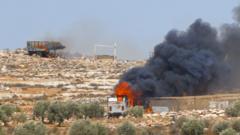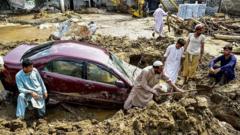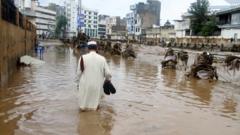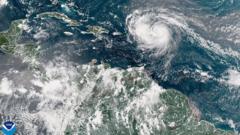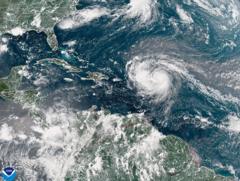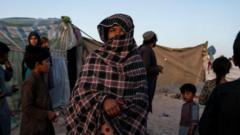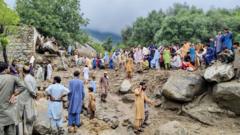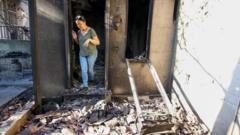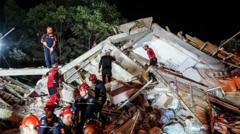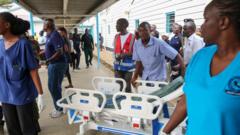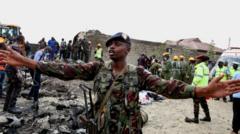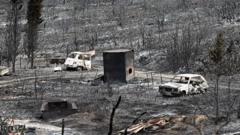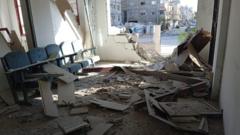"Recent torrential rains and subsequent flooding in northern Pakistan have resulted in at least 314 deaths, with Buner district experiencing the worst devastation. Local rescue efforts continue amidst the destruction of homes and crops, as communities rally to support one another."
"Devastating Floods Claim Lives in Northern Pakistan: A Community in Mourning"
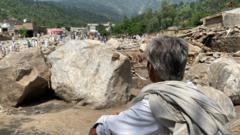
"Devastating Floods Claim Lives in Northern Pakistan: A Community in Mourning"
"Historic rains lead to catastrophic floods, claiming hundreds of lives and leaving entire villages in ruins."
The picturesque village of Bishnoi in northern Pakistan, once cradled by the region's lush greenery, is now a shadow of its former self following recent catastrophic floods. On the morning of August 15, villagers awoke to the sound of violent rains, completely unprepared for the torrent that would soon descend upon them. The deluge unleashed a wave of destruction, sweeping through the village and reducing it to rubble, carrying massive rocks and obliterating buildings in its path.
In the aftermath of the disaster, local residents are engaged in a desperate search for survivors beneath the debris. Rescue workers, faced with minimal resources and heavy machinery limited, rely on hand tools to sift through concrete blocks and uprooted trees. "There is a house under every stone. People try to look underneath these rocks to see if they can find someone," lamented local resident Israr Khan. The situation is dire, as approximately 314 fatalities and 156 injuries have been reported due to rain-related incidents across Khyber Pakhtunkhwa province, with Buner district being remarkably hard-hit.
The impact of the floods has been especially devastating on the community of Bishnoi, once home to roughly 90 households predominantly involved in agriculture. Locals report that up to 50 percent of residential structures have been destroyed entirely, with many families now left homeless. Preliminary investigations reveal that a wedding house was among those that bore considerable losses, underscoring the personal tragedies that accompany the wider devastation.
Global warming is cited as a contributing factor, worsening the monsoon season's impact on Pakistan, where approximately 650 lives have already been lost this weather cycle. Since late June, rain-related disasters have claimed over 507 lives nationwide, and heavy rains are forecasted to persist through August 21, as authorities scramble to establish disaster zones in affected areas.
Acts of heroism have emerged, as evidenced by Saeed Ahmad, a school principal in the nearby Swat Valley who successfully evacuated nearly 900 students moments before floodwaters ravaged the school. Tragically, not all families managed to escape; Abdul Salam from Punjab recalls the harrowing moment he lost contact with his wife and children during the flood.
Rescue activities are ongoing, even as survivors wrestle with their new reality. In Buner, Asrar Khan reports that 27 community members are still missing. As the skies continue to weep and the waters rise, community solidarity emerges amid collective grief. Relief agencies have mobilized to render assistance, while volunteers from surrounding areas join the monumental task of recovery and restoration.
The harrowing realities of the floods serve as a stark reminder of nature's unpredictability and the urgent need for collective action to address climate changes impacting vulnerable communities. Each day, the search continues for the missing, as families claim the pieces of their shattered lives amid the ruins left by the floods.
In the aftermath of the disaster, local residents are engaged in a desperate search for survivors beneath the debris. Rescue workers, faced with minimal resources and heavy machinery limited, rely on hand tools to sift through concrete blocks and uprooted trees. "There is a house under every stone. People try to look underneath these rocks to see if they can find someone," lamented local resident Israr Khan. The situation is dire, as approximately 314 fatalities and 156 injuries have been reported due to rain-related incidents across Khyber Pakhtunkhwa province, with Buner district being remarkably hard-hit.
The impact of the floods has been especially devastating on the community of Bishnoi, once home to roughly 90 households predominantly involved in agriculture. Locals report that up to 50 percent of residential structures have been destroyed entirely, with many families now left homeless. Preliminary investigations reveal that a wedding house was among those that bore considerable losses, underscoring the personal tragedies that accompany the wider devastation.
Global warming is cited as a contributing factor, worsening the monsoon season's impact on Pakistan, where approximately 650 lives have already been lost this weather cycle. Since late June, rain-related disasters have claimed over 507 lives nationwide, and heavy rains are forecasted to persist through August 21, as authorities scramble to establish disaster zones in affected areas.
Acts of heroism have emerged, as evidenced by Saeed Ahmad, a school principal in the nearby Swat Valley who successfully evacuated nearly 900 students moments before floodwaters ravaged the school. Tragically, not all families managed to escape; Abdul Salam from Punjab recalls the harrowing moment he lost contact with his wife and children during the flood.
Rescue activities are ongoing, even as survivors wrestle with their new reality. In Buner, Asrar Khan reports that 27 community members are still missing. As the skies continue to weep and the waters rise, community solidarity emerges amid collective grief. Relief agencies have mobilized to render assistance, while volunteers from surrounding areas join the monumental task of recovery and restoration.
The harrowing realities of the floods serve as a stark reminder of nature's unpredictability and the urgent need for collective action to address climate changes impacting vulnerable communities. Each day, the search continues for the missing, as families claim the pieces of their shattered lives amid the ruins left by the floods.

